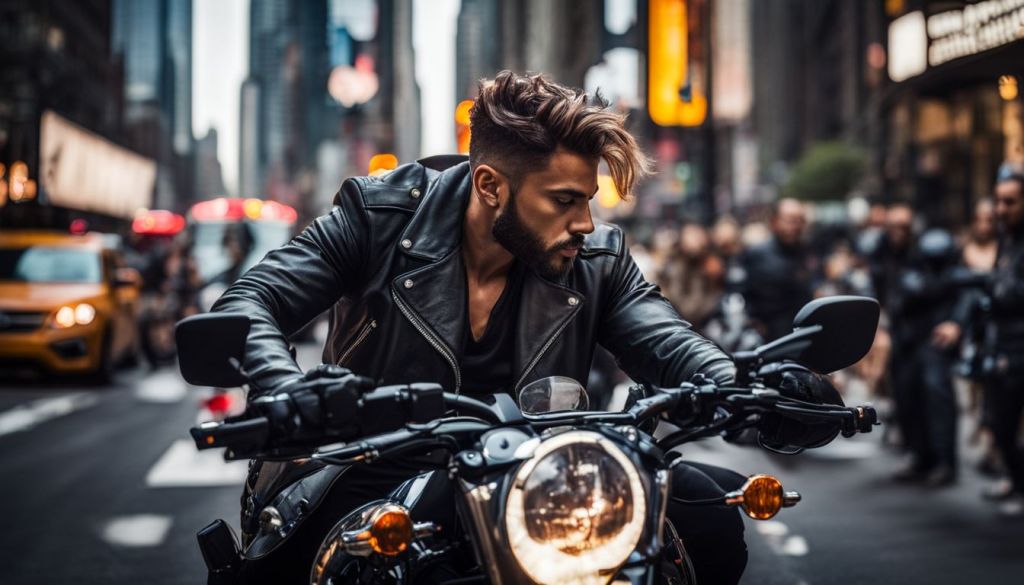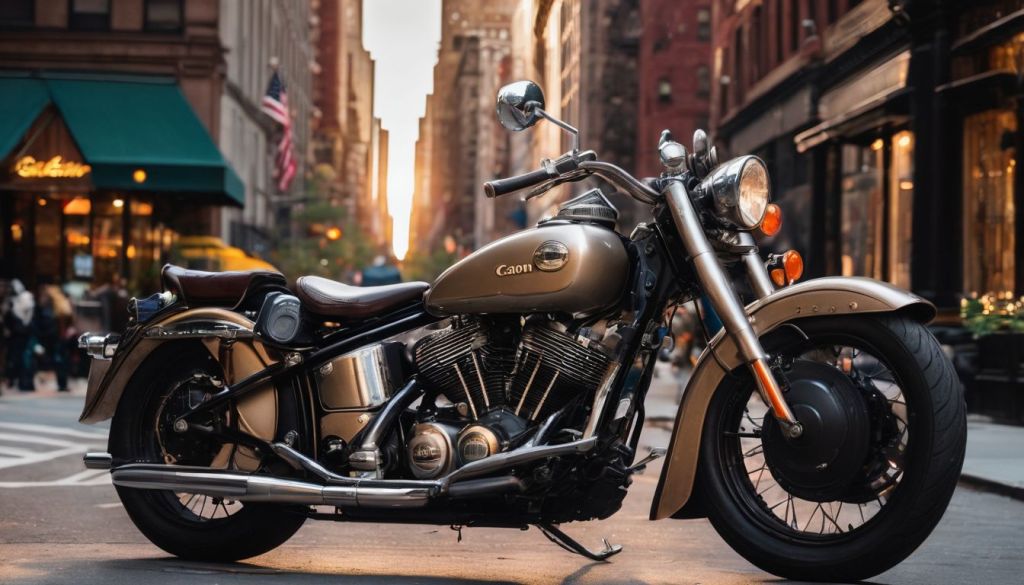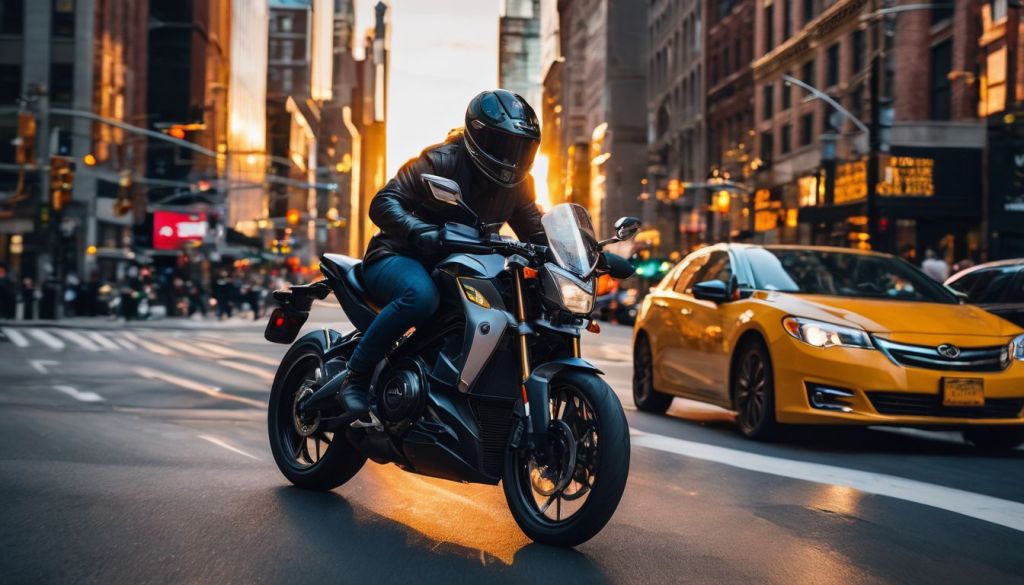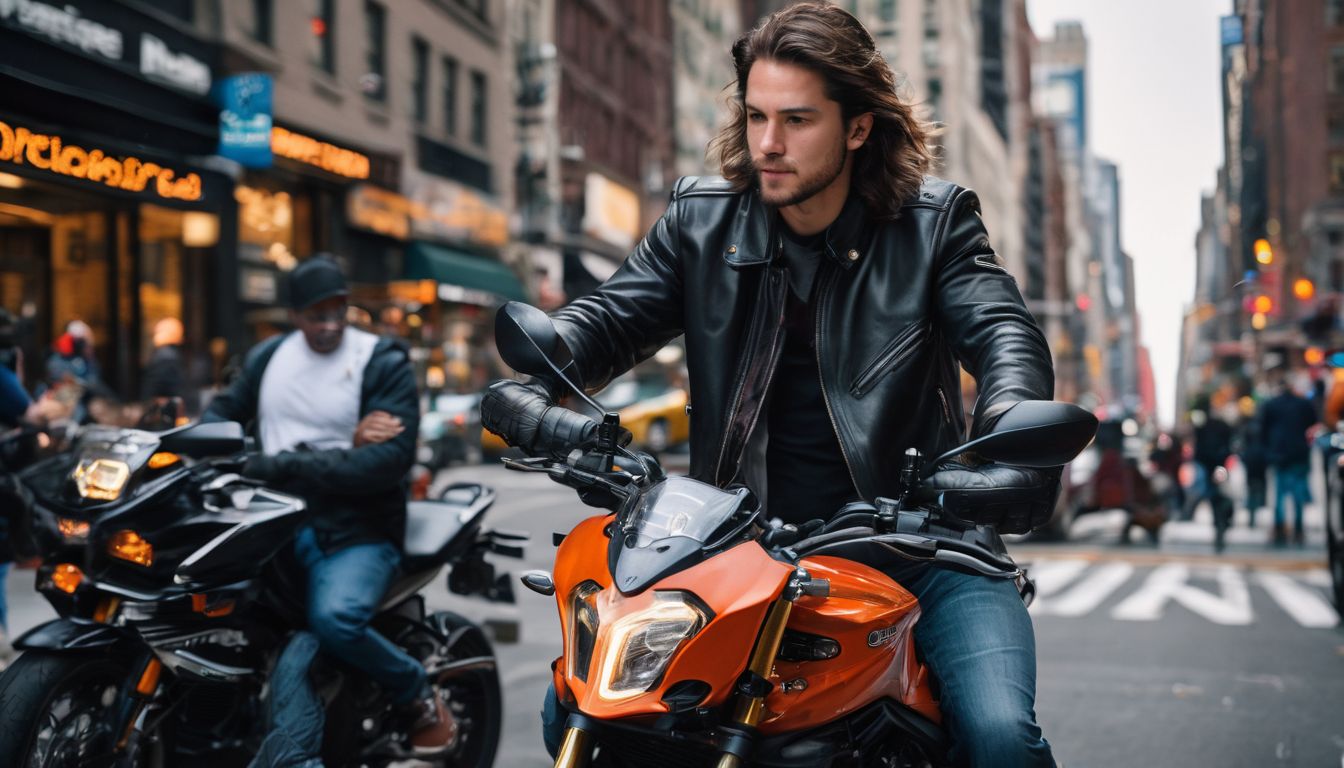
Navigating the concrete jungle of New York City on two wheels offers a sense of freedom and agility that four-wheeled vehicles can’t match. But this exhilarating mode of transport comes with its unique set of challenges, especially when it pertains to maintenance.
As an experienced motorcyclist who has clocked thousands of miles in urban settings, I’ve honed my skills not only in maneuvering through busy streets but also in keeping my ride in top condition amidst the demanding environment.
To thrive as a rider here requires more than just knowing how to twist the throttle; it demands vigilance towards maintaining your motorcycle so it won’t let you down on these bustling roads.
Regular checks for tire pressure and brake fluid are vital—a truth all city riders learn quickly for their safety and peace of mind. Stay tuned for essential tips that will keep both newbies and seasoned bikers road-ready in NYC’s urban landscape.
Ready to roll? Let’s dive in.
Key Takeaways
- Regular motorcycle maintenance is crucial for safe riding in NYC, including routine oil changes, tire pressure checks, and ensuring lights and horns work properly.
- Being highly visible to other road users is essential; this can be achieved by wearing bright-colored gear with reflective strips and using functional bike lights.
- Practice critical maneuvers like quick stops, swerving, emergency evasion, tight turns, and low – speed balancing in a parking lot to enhance control on busy streets.
- Always wear protective gear such as a full – face helmet, gloves with grip control, armored jackets, pants for body protection, and stay sober while riding.
- Develop situational awareness by scanning the environment for possible dangers like open car doors or potholes and maintaining a defensive riding strategy.
Understanding City Riding for New Riders in NYC

Navigating the bustling streets of New York City on a motorcycle can be simultaneously exhilarating and daunting for new riders. Mastering the urban landscape requires honing skills unique to the city’s rhythm, traffic flow, and myriad challenges that await on every corner.
Riding with an Expert
Learning how to maneuver the concrete jungle of New York City on a motorcycle can be a daunting task. Opting for time with an expert rider is like having a personal guide through the maze of urban traffic.
These seasoned pros offer invaluable insights from years on the road, sharing tips that books and manuals simply can’t provide. They demonstrate how to weave safely through heavy traffic and how maintaining cool composure ensures you stay safe amidst bustling city streets.
Expert riders stress the importance of routine maintenance, such as ensuring your lights, horn, and mirrors are in prime condition—crucial elements when navigating chaotic intersections or signaling your presence to other motorists.
They teach you defensive techniques like keeping a safe following distance and riding within your abilities; skills that become second nature with practice. Under their tutelage, new habits form; checking tire pressure becomes as routine as strapping on your helmet, and scanning ahead for potential hazards turns into instinct.
Once confidence builds under expert guidance, it’s time to expand boundaries beyond quieter roads onto busier byways. The transition involves starting on the periphery where traffic is less intense—a perfect segue into mastering city riding dynamics while still under watchful eyes before facing NYC’s iconic avenues solo.
Starting on the Periphery
Begin your urban motorcycle journey by exploring the less crowded areas of New York City. Starting on the outskirts allows you to gradually adapt to city riding conditions without being overwhelmed.
Here, traffic is not as hectic, and you have more space to practice maneuvers and build confidence. It’s crucial to get a feel for your bike in an environment that is forgiving, so choosing roads that aren’t packed with cars and pedestrians can make a significant difference in your comfort level.
Familiarize yourself with neighborhood streets before diving into the dense traffic of downtown areas. This approach helps solidify basic vehicle control and situational awareness in settings where stakes aren’t as high.
A well-maintained motorcycle responds better, turns smoother, and brakes more reliably – essential for keeping safe in any urban scenario; ensure routine maintenance tasks like regular oil changes and tire inspections are up-to-date.
Gradually integrate into busier parts of the city once you’ve mastered these quieter spaces. Always remember that wearing protective gear is non-negotiable no matter where you ride – it’s your best defense against unpredictable road elements.
As you become part of the vibrant flow of urban commuting, stay vigilant and defensive while enjoying what motorcycle life in New York City offers.
Riding in Quiet Hours
Choosing to ride your motorcycle during quiet hours can make a big difference in the urban landscape of New York City. It’s during these times that traffic is less congested, allowing for smoother rides and giving new riders the chance to get comfortable with their bikes.
Early mornings or late evenings often present this perfect window where you can navigate city streets with ease, sharpening your skills without the pressure of rush hour chaos.
Plan short routes during these off-peak hours to build confidence and practice maneuvering your motorcycle through tighter spots that are typically clogged during busier times. Taking advantage of quiet hours not only helps in honing riding techniques but also significantly reduces stress levels, making it an optimal time for both learning and enjoying the unique experience of city biking.
Embrace these moments to familiarize yourself with different aspects of motorcycle maintenance like checking tire pressure or adjusting mirrors which becomes much easier when there’s less traffic around.
Developing Situational Awareness
Developing situational awareness is essential for the urban rider navigating New York City’s chaotic streets. Riders must constantly scan their environment, anticipating potential hazards like open car doors, potholes, and erratic pedestrians.
This means keeping your eyes moving and observing not just the cars ahead but also those in your rearview mirrors. Sharp reflexes go hand in hand with sharp eyesight; being able to react quickly can be the difference between a close call and an accident.
Mastering this skill involves predicting other drivers’ actions before they make them, such as turning or changing lanes without signaling. Motorcyclists should always assume that they are invisible to others on the road and ride defensively.
Maintaining a heightened sense of awareness helps you stay one step ahead in this unpredictable urban landscape. Up next: Practicing Critical Maneuvers – prepare to refine your riding skills further for safer journeys through city traffic.
Practicing Critical Maneuvers
Mastering critical maneuvers is essential for safe urban motorcycle riding. This practice builds skills necessary to navigate through New York City’s unpredictable streets.
- Learn the art of quick stops:
- Prepare for sudden halts by practicing quick, controlled braking.
- Apply front and rear brakes smoothly to avoid skidding.
- Perfect your swerving technique:
- Swerve safely to dodge obstacles without losing control.
- Practice leans and counter – steering in an open parking lot.
- Hone emergency evasion:
- Anticipate potential hazards and rehearse swift maneuvers to evade them.
- Stay alert and always have an escape route in mind while riding.
- Execute tight turns with confidence:
- Manage slow, tight turns by mastering clutch and throttle control.
- Keep your head up and look through the turn, not down at the road.
- Refine balancing at low speeds:
- Improve control during traffic crawls or when maneuvering in small spaces.
- Use fine throttle inputs and rear brake for stability.
Motorcycle Safety Tips for Urban Riders
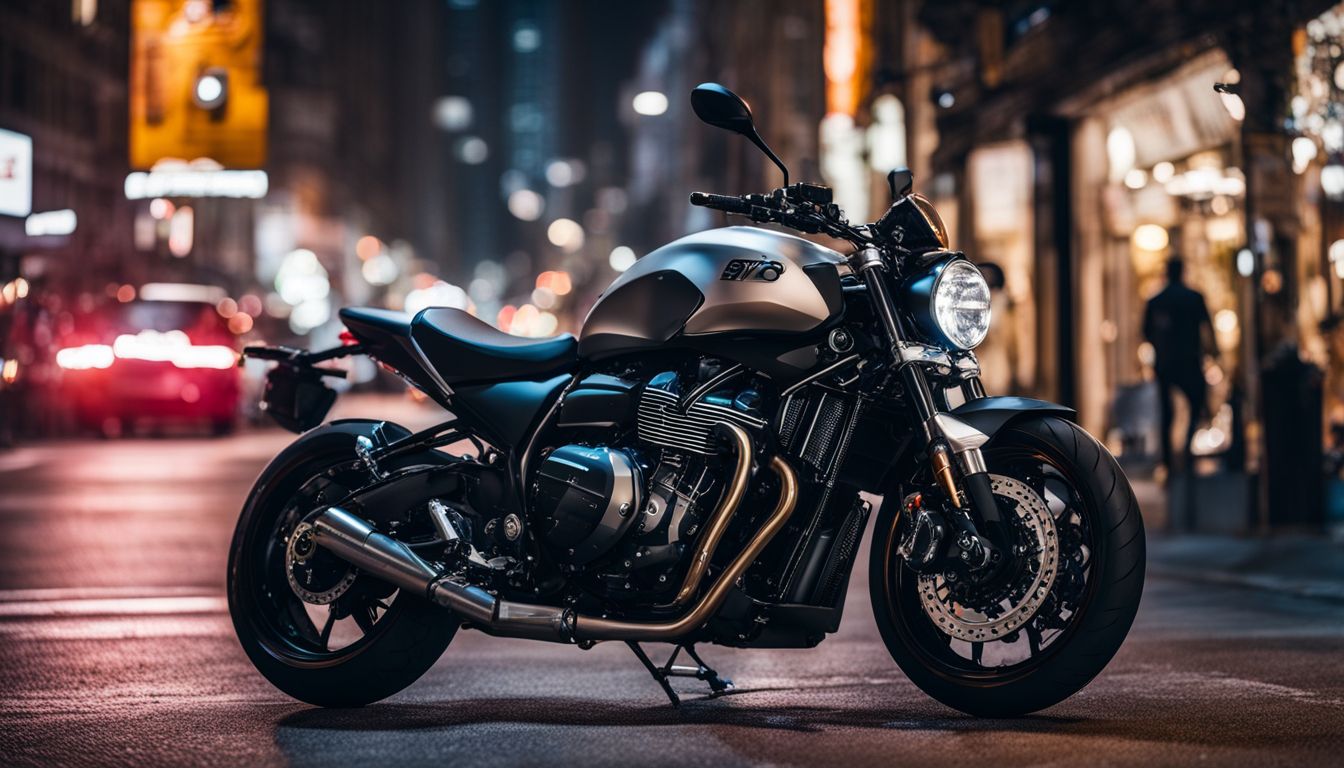
For the urban rider weaving through New York City’s bustling streets, motorcycle safety transcends careful driving—it’s about making strategic choices that ensure visibility and protection.
These carefully curated tips offer the essential groundwork for riding with confidence in an unpredictable urban landscape.
Riding Responsibly
Riding responsibly is a fundamental aspect of motorcycle safety, especially in the bustling streets of New York City. It starts with understanding your motorcycle’s capabilities and limits.
Urban riders must maintain focus on their environment, scanning for potential hazards and reacting proactively to avoid accidents. This means allowing sufficient space between other vehicles and staying visible at all times through the strategic positioning on the road.
Motorcycle commuting demands not just skill but also discipline; hence urban riders need to respect traffic laws and signals without exception. Anticipate sudden stops, watch for pedestrians, and never weave through traffic recklessly.
Adhering strictly to speed limits while recognizing that city riding often requires adjusting pace according to fluctuating conditions is vital for safe commuting. Defensive riding techniques are non-negotiable when it comes to navigating dense urban traffic where unpredictability is the only constant.
Wearing Protective Gear
Dress for the slide, not just the ride. Protective gear is your primary defense against injuries when you’re navigating urban roads. A full-face helmet guards your head and face, significantly reducing the risk of a traumatic brain injury during an accident.
It’s not enough to just strap on any helmet; ensure it meets safety standards and fits snugly. Gloves are also essential – they protect your hands from abrasion and allow better grip control.
Jackets and pants with built-in armor offer protection for other vital areas like elbows, hips, and knees. While these pieces might feel bulky at first, modern motorcycle apparel is designed for comfort as well as safety – combining functionality with protective elements that can save your skin in case of a fall or collision.
Reflective materials increase visibility to others on the road, making them indispensable in heavy traffic scenarios common to city riding environments. After gearing up safely, make sure you’re seen by others by focusing on making yourself visible.
Making Yourself Visible
High visibility on the bustling streets of New York City is a game-changer for motorcycle riders. Lighting up like a Broadway marquee, your ride needs bright-colored gear and reflective strips that catch the eye of every pedestrian and driver.
Equip your bike with lights that are in top-notch condition; this doesn’t just mean headlights, but also brake lights and turn signals must be clear and fully functional. Always check before you hit the road—lights can be lifesavers in the urban jungle.
Switching lanes or taking turns without grabbing attention can lead to trouble in traffic-heavy areas. Use hand signals along with your bike’s indicators to communicate your intentions to everyone around you clearly.
A good set of mirrors adjusted accurately will help you keep an eye on who’s behind while making sure they see you too.
To enhance safety further, consider honing your riding skills away from busy streets at first; find an open parking lot where maneuverability skills can be sharpened without distractions.
Moving on from staying visible, let’s focus on another critical aspect – navigating through tight spots safely at “Hone Your Skills in a Parking Lot.”
Hone Your Skills in a Parking Lot
After ensuring you are visible on the road, it’s essential to focus on honing your riding skills. Practicing in a parking lot allows you to refine your motorcycle control without the stress of city traffic.
- Seek out a spacious, empty parking lot where you can practice without interruptions or hazards. Look for one that’s not frequently used, especially on weekends or during off-hours.
- Begin with basic maneuvers like starting, stopping, and turning. Repeatedly perform these actions until they feel natural and you can do them smoothly.
- Set up cones or use existing parking lines to navigate through tight turns and figure – eight patterns. This helps improve your ability to maneuver in confined spaces.
- Practice emergency stops to get comfortable with how your bike responds under sudden braking conditions. Controlled stopping is crucial for urban commuting.
- Work on perfecting your balance at slow speeds, as maintaining control at low velocities is often required in congested city riding conditions.
- Simulate real – world scenarios such as weaving through stalled traffic or avoiding unexpected obstacles to be prepared for city riding challenges.
Avoiding Alcohol While Riding
Riding a motorcycle requires full concentration and quick reflexes, especially in the unpredictable conditions of city traffic. Drinking alcohol impairs these vital functions, increasing the risk of accidents.
Urban riders should commit to staying sober when they plan to ride. Alcohol not only slows reaction times but also affects judgment and coordination—skills that are essential for safe riding.
Stay clear-headed on your bike; even one drink can compromise your ability to maneuver through congested streets safely. For urban motorcycle commuters, avoiding alcohol is a key aspect of defensive driving and personal safety strategy.
Keep yourself and others on the road safe by making responsible choices before you start your engine. Now let’s shift gears and focus on regular motorcycle maintenance as another critical element for smooth city riding.
Importance of Motorcycle Maintenance
Regular upkeep is the backbone of motorcycle reliability, particularly for those navigating New York City’s demanding urban terrain. Maintaining your motorcycle not only ensures a smoother ride but also significantly reduces the risk of unexpected breakdowns amidst the bustling city streets.
Regular Oil Changes
Regular oil changes are vital for keeping your motorcycle in top condition, especially on the busy streets of New York City. This routine maintenance task keeps your engine running smoothly and prolongs its lifespan. Here’s how to stay on top of this essential aspect of motorcycle upkeep:
- Check Your Motorcycle Manual: Consult your motorcycle manual to determine the recommended oil change interval. Each model has specific needs that must be adhered to for optimal performance.
- Select the Right Oil: Use the type and grade of oil suggested by your motorcycle manufacturer. This ensures that your bike’s engine receives the best lubrication suited for its design.
- Gather Necessary Tools: Prepare all tools and equipment needed for an oil change, such as a wrench, oil filter, funnel, and drain pan. Having these on hand streamlines the process.
- Warm Up Your Engine: Run your motorcycle’s engine for a few minutes before draining the oil. Warm oil flows better and allows impurities to flush out more effectively.
- Drain Old Oil Completely: Locate the drain plug and carefully remove it to let old oil flow into a pan. Make sure you dispose of used oil responsibly according to local regulations.
- Replace Oil Filter: Always change the oil filter with every oil change. A fresh filter is crucial in catching debris or contaminants that might circulate through your engine.
- Refill with Fresh Oil: Pour new oil into your motorcycle through a clean funnel, ensuring you add the correct amount as stated in your manual.
- Check for Leaks: After replacing the cap securely, turn on your bike’s engine briefly and inspect for any signs of leakage around the drain plug or filter area.
- Dispose of Old Oil Properly: Bring used motor oil to a designated recycling center or auto shop that accepts it – never pour it down drains or onto the ground.
Checking Tire Pressure
Checking tire pressure on your motorcycle is a critical step in urban motorcycle maintenance. Properly inflated tires are key to safe and efficient city riding.
- Locate the proper PSI: Start by checking your motorcycle manual for the recommended tire pressure (PSI) for your specific model. This information can typically be found on a sticker attached to the swingarm or under the seat as well.
- Use a quality gauge: Invest in a reliable tire pressure gauge to ensure accuracy when measuring your tires’ PSI levels. Avoid using gas station gauges, which may be inaccurate due to overuse.
- Check when cold: Always measure your tire pressure when the tires are cold, as heat can cause expansion and give false readings. Do this by waiting at least three hours after riding.
- Remove valve cap: Carefully unscrew the valve cap from the tire’s valve stem. Keep it safe; you’ll need to put it back on after you’ve checked and adjusted the pressure.
- Press gauge onto valve stem: Firmly press your tire pressure gauge onto the valve stem until it stops hissing and read the measurement promptly for an accurate result.
- Inflate if necessary: If your reading is below the recommended PSI, add air with a compressor until you reach the correct pressure. Conversely, if over-inflated, press down on the center pin of the valve stem to release excess air.
- Recheck for accuracy: After adjusting, re-measure to make sure that you’ve achieved the desired PSI level before replacing the valve cap securely.
- Inspect for damage: While checking pressure, inspect your tires for any signs of wear or damage such as cracks or embedded objects that could lead to punctures or blowouts while riding.
Ensuring Lights and Horn are Working
After you’ve confirmed that your motorcycle’s tire pressure is correct, shift your focus to the bike’s lighting and horn systems. These features are essential for safety on the bustling streets of New York City, helping you communicate with other road users.
- Verify your headlights are functioning both for daytime running and night – time visibility. During the day, they increase your visibility to others, while at night they light your path and ensure you are seen.
- Test both high beam and low beam settings regularly as urban riding often transitions from well-lit streets to darker areas.
- Ensure tail lights and brake lights are operational. These alert drivers behind you when you’re slowing down or stopping.
- Check turn signals on both the front and rear. Functional indicators are crucial for safe lane changes and turns in the city traffic.
- Inspect auxiliary lights if your motorcycle is equipped with them. They can provide additional visibility during adverse weather conditions or at night.
- Test your horn frequently to make sure it’s loud and clear. A working horn can be a lifesaver when you need to quickly get someone’s attention in an emergency situation.
- Clean all light covers periodically to remove grime and residue that can dim their brightness. This is particularly important in an urban environment where pollution can build up on surfaces.
- Replace any burnt – out bulbs or repair any electrical issues immediately. Even short trips in the city can become dangerous without proper signaling ability.
Adjusting Mirrors
Proper visibility is crucial for motorcycle safety, especially after confirming that lights and horn are in working order. Next, focus on adjusting mirrors for maximum awareness of surroundings.
- Position yourself squarely on the motorcycle seat and hold the handlebars as if you were riding. This will give you the most accurate angle to set your mirrors.
- Use both hands to gently move each mirror. You should see a small portion of your shoulders on the inside edge of the reflection.
- Check that the horizon forms a straight line across the middle of each mirror to ensure a balanced rear view.
- Make sure no part of your motorcycle or accessories blocks critical areas within the mirror’s scope.
- Adjust for blind spots by slightly leaning while seated, then position mirrors so just at that lean, you can see vehicles that may be hidden.
- Have a friend walk around your bike to make sure you can follow their movement through your mirrors without losing sight of them.
- If needed, purchase mirror extenders or wider mirrors which provide a better field of vision in heavy urban traffic conditions like those found in New York City.
Inspecting Tires for Proper Inflation
Checking tire pressure regularly is essential for motorcycle safety, especially in an urban environment like New York City. Correctly inflated tires ensure your motorcycle handles properly and safely on city streets.
- Find the recommended tire pressure for your bike in the motorcycle manual. This number is crucial as it tells you exactly how much air your tires need.
- Use a reliable tire pressure gauge to check the current pressure. It’s best to do this when the tires are cold, before riding, as heat can affect the reading.
- Compare the measured pressure with the recommended level. If it’s too low or too high, you’ll need to adjust it accordingly.
- Inflate or deflate the tires using an air compressor or a hand pump. Many gas stations have air compressors available for public use.
- Inspect the tire surface for any cuts, bulges, or objects that may have punctured them. These can compromise tire integrity and require immediate attention.
- Check tire sidewalls for cracks or weather damage. Over time, environmental factors can degrade rubber and lead to potential failure.
- Rotate the wheels slowly by hand and inspect for any uneven wear patterns. Uneven wear can indicate issues with alignment or suspension that need professional attention.
- Repeat this process at least once a month or more frequently if you ride daily. Urban roads can be tough on tires so staying vigilant helps avoid unexpected issues.
- Make inspecting your tires part of your basic motorcycle maintenance checklist. Integrating this task into your routine ensures you don’t overlook this vital aspect of motorcycle upkeep.
Conclusion
Keep your motorcycle in top shape to tackle the urban jungle of New York City with confidence. Remember, routine maintenance isn’t just a good habit—it’s your shield against the unexpected on crowded streets.
Gear up, stay alert, and maintain your ride; this trifecta is your key to a safer and more enjoyable urban riding experience. Every check and adjustment empowers you for smoother commutes and less hassle on the road.
Ride smart, prioritize upkeep, and make every journey through NYC an epic one.
FAQs
1. What is the first step in maintaining my motorcycle in NYC?
Regularly inspect your motorcycle for any visible wear or damage, especially before a ride.
2. How often should I check tire pressure on my motorcycle?
Check your tire pressure at least once a week to ensure safety and optimum performance.
3. Why is cleaning my motorcycle important in an urban environment like New York City?
Cleaning removes dirt and grime that can cause damage over time, keeping your bike in top condition.
4. Can changing the oil affect my motorcycle’s performance?
Yes, timely oil changes are crucial for maintaining engine health and ensuring smooth operation.
5. What maintenance task is essential for rider safety on busy NYC streets?
Regularly checking and adjusting brakes ensures you can stop effectively in urban traffic conditions.
